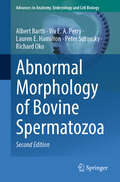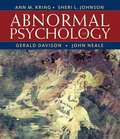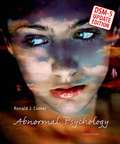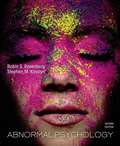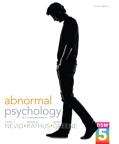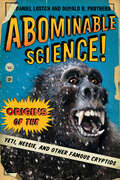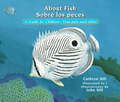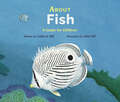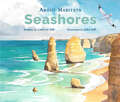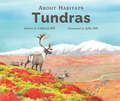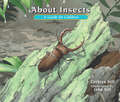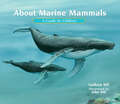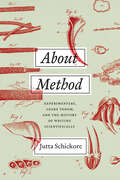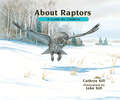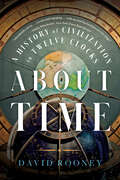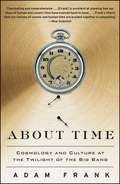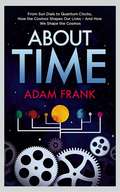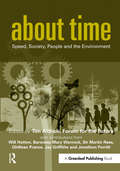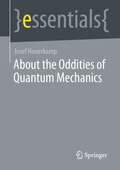- Table View
- List View
Abnormal Morphology of Bovine Spermatozoa (Advances in Anatomy, Embryology and Cell Biology #240)
by Peter Sutovsky Albert Barth Viv E. Perry Lauren E. Hamilton Richard OkoThis book provides a broad perspective on understanding bovine fertility, focusing on the classification and interpretation of bovine sperm defects. Building upon the success of its first edition published in 1989, this new edition has been significantly updated and expanded to reflect developments over the past three decades. The chapters cover topics such as the normal and abnormal development of bovine sperm, the mechanisms behind sperm defects, and the impact of these defects on fertility. Special attention is drawn at advances in genomic research and the use of sperm quality biomarkers and genetic screening tests in the assessment of bull fertility. In addition to this, the work explores critical periods for sexual development in bulls, such as early gestation and pre-weaning. This monograph is intended for researchers and students in the field of animal reproduction, veterinarians, and animal scientists. It provides a deep understanding of bovine fertility, a topic that is crucial for anyone working in livestock production or related fields. The knowledge gained from this book will be beneficial to those seeking to improve livestock productivity and thus contribute to global food security.
Abnormal Psychology (12th Edition)
by Ann M. Kring John M. Neale Gerald C. Davison Sheri JohnsonAbnormal Psychology 12th Edition, continues the tradition of giving students the opportunity to explore the latest theories and research in the field. It has been adapted to take into account UK/European examples in diagnosis and classifcation of mental illness, statistics on misuse of drugs and treatment as well as a fully revised chapter with European examples on legal and ethical issues. As distinguished scholars and leaders in the field of Psychology, our author team continues to emphasize recent and comprehensive research coverage that has been the hallmark of the text. Significant new material correlated to the forthcoming Diagnostic and Statistical Manual of Mental Disorders 5 (DSM-5), included in every chapter. Abnormal Psychology emphasizes an integrated approach, showing how psychopathology is best understood by considering multiple perspectives, and how these varying perspectives can provide us with the clearest accounting of the causes of these disorders as well as the best possible treatments. Created for the 11th edition, we continue to offer a powerful video series for your Abnormal Psychology course with 7-10 minute clips to show in class or for students to review outside of class to help understand the patients experience. Unlike other videos, these feature real patients' and their families, in the context of their lives, describing symptoms from their own perspective. Each video provides concise information about the available treatment options.
Abnormal Psychology (Eighth Edition)
by Ronald J. ComerAn inspiring and clearly written graduate textbook with psychology concepts explained in a way easy to comprehend with updates on DSM-5.
Abnormal Psychology (Second Edition)
by Robin S. Rosenberg Stephen M. KosslynThis is an exciting time to study psychopathology. Research on the entire range of psychological disorders has blossomed during the last several decades, producing dramatic new insights about psychological disorders and their treatments.
Abnormal Psychology in a Changing World
by Jeffrey S. Nevid Spence A. Rathus Beverly S. GreeneAbnormal Psychology in a Changing World, 9/e uses first-person narratives from people struggling with psychological disorders as a pedagogical framework. Updated to reflect the revision of the Diagnostic and Statistical Manual (DSM-5), the authors endeavor to bring research developments and advancements in abnormal psychology to students. Through illustrative case examples drawn from the authors' own experiences, they recognize there is a human dimension to the study of abnormal psychology.
Abominable Science!: Origins of the Yeti, Nessie, and Other Famous Cryptids
by Donald R. Prothero Daniel LoxtonThroughout our history, humans have been captivated by mythic beasts and legendary creatures. Tales of Bigfoot, the Yeti, and the Loch Ness monster are part of our collective experience. Now comes a book from two dedicated investigators that explores and elucidates the fascinating world of cryptozoology. Daniel Loxton and Donald R. Prothero have written an entertaining, educational, and definitive text on cryptids, presenting the arguments both for and against their existence and systematically challenging the pseudoscience that perpetuates their myths. After examining the nature of science and pseudoscience and their relation to cryptozoology, Loxton and Prothero take on Bigfoot; the Yeti, or Abominable Snowman, and its cross-cultural incarnations; the Loch Ness monster and its highly publicized sightings; the evolution of the Great Sea Serpent; and Mokele Mbembe, or the Congo dinosaur. They conclude with an analysis of the psychology behind the persistent belief in paranormal phenomena, identifying the major players in cryptozoology, discussing the character of its subculture, and considering the challenge it poses to clear and critical thinking in our increasingly complex world.
Abominable Science!: Origins of the Yeti, Nessie, and Other Famous Cryptids
by Donald R. Prothero Daniel Loxton&“A sharp analysis of the quest for unreal critters―cryptids, as they are called―and the people who pursue them . . . entertaining and thoroughly documented.&” —The Wall Street Journal Throughout our history, humans have been captivated by mythic beasts and legendary creatures. Tales of Bigfoot, the Yeti, and the Loch Ness monster are part of our collective experience. Now comes a book from two dedicated investigators that explores and elucidates the fascinating world of cryptozoology. Daniel Loxton and Donald R. Prothero have written an entertaining, educational, and definitive text on cryptids, presenting the arguments both for and against their existence and systematically challenging the pseudoscience that perpetuates their myths. After examining the nature of science and pseudoscience and their relation to cryptozoology, Loxton and Prothero take on Bigfoot; the Yeti, or Abominable Snowman, and its cross-cultural incarnations; the Loch Ness monster and its highly publicized sightings; the evolution of the Great Sea Serpent; and Mokele Mbembe, or the Congo dinosaur. They conclude with an analysis of the psychology behind the persistent belief in paranormal phenomena, identifying the major players in cryptozoology, discussing the character of its subculture, and considering the challenge it poses to clear and critical thinking in our increasingly complex world. &“As valuable for its analysis of the hunted as it is for the light it shines on the still-hopeful hunters.&” —Publishers Weekly &“Highly recommended for readers looking for scientific but accessible evaluations of the existence of five notable cryptids that have captured our imaginations.&” —Library Journal (starred review)
About Fish / Sobre los peces: A Guide for Children / Una guía para niños (About. . . #21)
by Cathryn SillThis award-winning beginner's guide to the natural world of fish from the creators of the About... series was named an "NSTA Recommends" book. Noted educator and author Cathryn Sill uses simple, easy-to-understand language to teach children the basic characteristics of what fish are, how they swim, breathe, and reproduce, and explains the different ways they protect themselves from predators. With beautifully detailed, realistic paintings, noted wildlife illustrator John Sill introduces readers to the diversity of the fish population, from an Arctic char to a porcupine fish. An afterword provides more details, inspiring further learning. This book is ideal for early childhood and elementary units in science, environment, and marine life.
About Fish: A Guide for Children (About. . . #6)
by Cathryn SillThis award-winning beginner's guide to the natural world of fish from the creators of the About... series was named an "NSTA Recommends" book. Noted educator and author Cathryn Sill uses simple, easy-to-understand language to teach children the basic characteristics of what fish are, how they swim, breathe, and reproduce, and explains the different ways they protect themselves from predators. With beautifully detailed, realistic paintings, noted wildlife illustrator John Sill introduces readers to the diversity of the fish population, from an Arctic char to a porcupine fish. An afterword provides more details, inspiring further learning. This book is ideal for early childhood and elementary units in science, environment, and marine life.
About Habitats: Seashores (About Habitats Ser. #8)
by Cathryn SillStudying nature? Going to the beach? Dig into this classroom favorite and beginner's guide to seashores from the creators of the award-winning About Habitats series.In this accessible introduction to a familiar locale, author and educator Cathryn Sill uses simple, easy-to-understand language to teach children about seashores and their diversity, the types of animals and plants that live there, and why they're important. The stunning paintings by noted wildlife illustrator John Sill depict the wide variety of seashore topography. A glossary and afterword provide more details about each seashore featured in the book. Perfect for early childhood and elementary units on nature, environment, and ecosystems.
About Habitats: Tundras (About Habitats #10)
by Cathryn SillThis beginner's guide to tundras explores the unique attributes of this cold habitat, showcasing its beauty and plant and animal diversity. Author and educator Cathryn Sill uses simple, easy-to-understand language to teach children what tundras are, what kinds of animals and plants live there, and how certain species have adapted to the unique environment. The book covers the characteristics of Arctic, Antarctic, and alpine tundras. John Sill's detailed, realistic paintings reflect the beauty and diversity of the habitat. A glossary and afterword provide more detail for further exploration. Ideal for early childhood and elementary education units on biomes and environments, geography, habitats, and nature.
About Hummingbirds: A Guide for Children (About. . . #14)
by Cathryn SillAn award-winning first glimpse into the world of hummingbirds.In this addition to the acclaimed About... series, author and educator Cathryn Sill uses simple, easy-to-understand language to teach children what hummingbirds are, how they look, how they move, what they eat, and where they live. The beautifully detailed, realistic paintings of noted wildlife illustrator John Sill introduce readers to the many varieties of hummingbirds—from the smallest type (the bee hummingbirds of Cuba) to the largest (the giant hummingbirds of the Andes Mountains in South America). An afterword inspires further learning. This beginner's guide to hummingbirds is perfect for early childhood and elementary units in science and animal life.
About Insects / Sobre los insectos: A Guide for Children / Una guía para niños (About. . . #18)
by Cathryn SillThis beginner's guide to insects is a must-have for bug-obsessed young learners as well as for those who are simply curious about these creatures. In this addition to the acclaimed About... series, author and educator Cathryn Sill uses simple, easy-to-understand language to teach children what insects are, how they look, how they move, what they eat, and where they live. With beautifully detailed, realistic paintings, noted wildlife illustrator John Sill introduces readers to a wide variety of insects, from ants and beetles to grasshoppers and the monarch butterfly. An afterword provides further details, inspiring young readers to learn more.
About Insects: A Guide for Children (About. . . #4)
by Cathryn SillThis beginner's guide to insects is a must-have for bug-obsessed young learners as well as for those who are simply curious about these creatures. In this addition to the acclaimed About... series, author and educator Cathryn Sill uses simple, easy-to-understand language to teach children what insects are, how they look, how they move, what they eat, and where they live. With beautifully detailed, realistic paintings, noted wildlife illustrator John Sill introduces readers to a wide variety of insects, from ants and beetles to grasshoppers and the monarch butterfly. An afterword provides further details, inspiring young readers to learn more.
About Mammals / Sobre los mamíferos: A Guide for Children / Una guía para niños (About. . . #15)
by Cathryn SillAn award-winning first glimpse into the diverse natural world of mammals.This addition to the acclaimed About... series explains to children in simple, easy-to-understand language what mammals are, what they eat, and where they live. Beautifully detailed, realistic paintings by wildlife illustrator John Sill introduce readers to the huge variety of mammals, from the tiny white-footed deermouse to the large American bison. An afterword provides more details about the animals featured in the book. Parents and pre-school and primary-grade teachers will find this an attractive choice for introducing kids to mammals.
About Mammals: A Guide for Children (About. . . #2)
by Cathryn SillAn award-winning first glimpse into the diverse natural world of mammals.This addition to the acclaimed About... series explains to children in simple, easy-to-understand language what mammals are, what they eat, and where they live. Beautifully detailed, realistic paintings by wildlife illustrator John Sill introduce readers to the huge variety of mammals, from the tiny white-footed deermouse to the large American bison. An afterword provides more details about the animals featured in the book. Parents and pre-school and primary-grade teachers will find this an attractive choice for introducing kids to mammals.
About Marine Mammals: A Guide for Children (About. . . #19)
by Cathryn SillA classroom favorite, this book provides a first glimpse of marine mammals that's ideal for budding oceanographers!In this beginner's guide, author and educator Cathryn Sill simply and clearly shows children what is essential for understanding and appreciating marine mammals—how they look, how they move, what they eat, and where they live. She covers animals as diverse as whales and otters to dolphins, polar bears, and more. The beautifully detailed, realistic paintings of noted wildlife illustrator John Sill depict a variety of marine mammals. An afterword provides more details for further exploration.
About Method: Experimenters, Snake Venom, and the History of Writing Scientifically
by Jutta SchickoreScientists’ views on what makes an experiment successful have developed dramatically throughout history. Different criteria for proper experimentation were privileged at different times, entirely new criteria for securing experimental results emerged, and the meaning of commitment to experimentation altered. In About Method, Schickore captures this complex trajectory of change from 1660 to the twentieth century through the history of snake venom research. As experiments with poisonous snakes and venom were both challenging and controversial, the experimenters produced very detailed accounts of their investigations, which go back three hundred years—making venom research uniquely suited for such a long-term study. By analyzing key episodes in the transformation of venom research, Schickore is able to draw out the factors that have shaped methods discourse in science. About Method shows that methodological advancement throughout history has not been simply a steady progression toward better, more sophisticated and improved methodologies of experimentation. Rather, it was a progression in awareness of the obstacles and limitations that scientists face in developing strategies to probe the myriad unknown complexities of nature. The first long-term history of this development and of snake venom research, About Method offers a major contribution to integrated history and philosophy of science.
About Parrots: A Guide for Children (About. . . #16)
by Cathryn SillA beautiful, informative first glance at the world of parrots.In this addition to the acclaimed About... series, author and educator Cathryn Sill uses simple, easy-to-understand language to teach children what parrots are, what they do, and how they live. With beautifully detailed, realistic paintings, noted wildlife illustrator John Sill introduces readers to the diverse population of parrots—from the colorful blue lorikeets of the Polynesian Islands to the rosy-faced lovebirds of southwestern Africa. An afterword provides more details for further exploration.
About Raptors: A Guide for Children (About. . . #13)
by Cathryn SillBudding birders will enjoy finding out about birds of prey in this award-winning first guide from the creators of the celebrated About... series.This beginner's guide uses simple, easy-to-understand language to teach children what raptors are, how they look, how they move, what they eat, and where they live. The beautifully detailed, realistic paintings of noted wildlife illustrator John Sill introduce readers to many varieties of raptors around the world, from the majestic bald eagle of North America to the sharp-eyed secretary bird of Africa. An afterword provides more information for eager young learners. Ideal for casual exploration as well as for early childhood and elementary science units on animals.
About Time: A History Of Civilization In Twelve Clocks
by David RooneyA captivating, surprising history of timekeeping and how it has shaped our world. For thousands of years, people of all cultures have made and used clocks, from the city sundials of ancient Rome to the medieval water clocks of imperial China, hourglasses fomenting revolution in the Middle Ages, the Stock Exchange clock of Amsterdam in 1611, Enlightenment observatories in India, and the high-precision clocks circling the Earth on a fleet of GPS satellites that have been launched since 1978. Clocks have helped us navigate the world and build empires, and have even taken us to the brink of destruction. Elites have used them to wield power, make money, govern citizens, and control lives—and sometimes the people have used them to fight back. Through the stories of twelve clocks, About Time brings pivotal moments from the past vividly to life. Historian and lifelong clock enthusiast David Rooney takes us from the unveiling of al-Jazari’s castle clock in 1206, in present-day Turkey; to the Cape of Good Hope observatory at the southern tip of Africa, where nineteenth-century British government astronomers moved the gears of empire with a time ball and a gun; to the burial of a plutonium clock now sealed beneath a public park in Osaka, where it will keep time for 5,000 years. Rooney shows, through these artifacts, how time has been imagined, politicized, and weaponized over the centuries—and how it might bring peace. Ultimately, he writes, the technical history of horology is only the start of the story. A history of clocks is a history of civilization.
About Time: Cosmology and Culture at the Twilight of the Big Bang
by Adam FrankThe Big Bang is all but dead, and we do not yet know what will replace it. Our universe’s “beginning” is at an end. What does this have to do with us here on Earth? Our lives are about to be dramatically shaken again—as altered as they were with the invention of the clock, the steam engine, the railroad, the radio and the Internet. In The End of the Beginning, Adam Frank explains how the texture of our lives changes along with our understanding of the universe’s origin. Since we awoke to self-consciousness fifty thousand years ago, our lived experience of time—from hunting and gathering to the development of agriculture to the industrial revolution to the invention of Outlook calendars—has been transformed and rebuilt many times. But the latest theories in cosmology— time with no beginning, parallel universes, eternal inflation—are about to send us in a new direction. Time is both our grandest and most intimate conception of the universe. Many books tell the story, recounting the progress of scientific cosmology. Frank tells the story of humanity’s deepest question— when and how did everything begin?—alongside the story of how human beings have experienced time. He looks at the way our engagement with the world— our inventions, our habits and more—has allowed us to discover the nature of the universe and how those discoveries, in turn, inform our daily experience. This astounding book will change the way we think about time and how it affects our lives.
About Time: From Sun Dials to Quantum Clocks, How the Cosmos Shapes our Lives - And We Shape the Cosmos
by Adam FrankFrom Stonehenge to beyond the Big Bang, an exhilarating scientific exploration of how we make time Time is the grandest conception of the universe that we humans have been able to imagine - and its most intimate, the very frame of human life. In About Time, astrophysicist and award-winning writer Adam Frank tells the scientific story of this wonderful and tyrannical invention. A Palaeolithic farmer moved through the sun-fuelled day and star-steered night in a radically different way than the Elizabethan merchants who set their pace to the clocks newly installed in their town squares. Since then, science has swept time into increasingly minute and standardized units - the industrial efficiency of ironworks' punch clocks; the space-age precision of atomic fountains and GPS satellites; the fifteen-minute increments of Outlook's digital revolution. And in the past decade, string-theory branes, multiverses, and "clockless" physics have begun to overturn our ideas about how the universe began - the Big Bang - in ways that will completely rewrite time and our experience of it. Weaving cosmology with day-to-day chronicles and a down-to-earth style, About Time is both dazzling and riveting as it confronts what comes next.
About Time: Speed, Society, People and the Environment
by Martin Rees Will Hutton Mary Warnock Geoff Mulgan Jay Griffiths Jonathon Porritt David Boyle Alexandra Jones Ghillean Prance Tim AldrichWhere does all the time go? Despite the burgeoning army of machines designed to save us time – from cars and aeroplanes to dishwashers and microwaves – we don't seem to have any more of it on our hands. We simply fill the space we clear with more things to do – consuming more, spending more – and then look around for new ways of saving time. And so we spiral onwards, upwards, ever faster. Being busy has become a habit, and a habit that gives us high status – busy people are important people. The business of business is busy-ness. We are moving from a world in which the big eats the small, to a world where the fast eats the slow. But the fallout from a society hooked on speed is everywhere. It's affecting our health: 60 per cent of the adult population in the UK report that they suffer from stress, and more than half of these say that this has worsened over the last 12 months. It's affecting our family life, with a quarter of British families sharing a meal together only once a month. And it affects our environment too: air travel is a major source of carbon dioxide emissions, accelerating climate change as we speed around the world. And the faster we live, the faster we consume, the faster we waste energy and the faster we pollute the planet. The faster we seem to be running out of time. Is there something fundamentally wrong with the structure and values of this high-speed society? What are we running from and what are we running towards? Sustainable development is all about time. It's about trying to safeguard the health of the planet, and the people it supports, indefinitely, unconstrained by time. The idea of time offers a novel perspective on what sustainable development is all about. Looking at issues affecting society and the environment through the prism of time conveys the urgency of the challenge and leads us to solutions we might not have thought of before. About Time, edited by the think-tank Forum for the Future, brings together ten of the world's leading thinkers and writers, including Will Hutton, Baroness Mary Warnock, Sir Martin Rees, Ghillean Prance, Jay Griffiths (the author of the bestselling Pip Pip) and Jonathon Porritt, from disciplines including biology, business, sociology, ethnography, astronomy, philosophy, politics, history and sustainability in a collection of intriguing essays exploring the issue of time and how it relates to the environment, economy and society. The first half of this collection looks at different dimensions of time – from the history of time as a social phenomenon and cultural notions of time, to cosmological time and the difference between human and machine time. These "think-pieces" are followed by a series of more practical, solutions-oriented contributions, looking at how we deal with time in different contexts – from the slow food movement and time banks to long-term thinking in politics and what we can individually do to cope with the speed society. Contributions are liberally interspersed with boxes and brief pieces offering bite-sized facts, figures and insights relating to time and our everyday lives. About Time is a high-profile collection aimed at creating debate about where the values of our contemporary society are taking us. It will foster reflective thinking about different aspects of time, using the concept of time to communicate and illuminate the idea of sustainable development and question our idolatry of speed. In doing so, it aims to inspire and help decision-makers in business, government and elsewhere to appreciate the challenges of sustainable development, and inspire individuals to create change in their own lives. For readers of No Logo and Longitude, this book provides a thought-provoking twist, bringing together time and sustainability in a refreshing, provocative and accessible way.
About the Oddities of Quantum Mechanics (essentials)
by Josef HonerkampQuantum mechanics is a physical theory for objects of the microcosm, e.g. for atoms or electrons. It has proven itself so far, but leads to the fact that we have to grant properties and relations to these objects, which are neither compatible with our common sense nor with the concepts of classical physics. These peculiarities are presented and their meaning for our cognitive faculty and for a world view is discussed.This Springer essential is a translation of the original German 1st edition essentials, Über die Merkwürdigkeiten der Quantenmechanik by Josef Honerkamp, published by Springer Fachmedien Wiesbaden GmbH, part of Springer Nature in 2020. The translation was done with the help of artificial intelligence (machine translation by the service DeepL.com). A subsequent human revision was done primarily in terms of content, so that the book will read stylistically differently from a conventional translation. Springer Nature works continuously to further the development of tools for the production of books and on the related technologies to support the authors.
